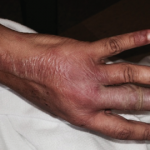Refractoriness
Over the past four decades I have had many cutaneous lupus erythematosus patients referred to me for “hydroxychloroquine resistance.” A good proportion of these patients were found to have been truly resistant to antimalarial monotherapy with hydroxychloroquine. Many of those patients responded to combination antimalarial therapy by adding quinacrine to the hydroxychloroquine for an appropriate period of time. Unfortunately, FDA regulatory actions have resulted in compounded quinacrine not being available on the U.S. market starting in 2016. However, quinacrine recently became available from certain compounding pharmacies that have been unwilling to divulge their source(s). These compounding pharmacies are offering quinacrine at a much higher price, making it unavailable to many patients as coverage of compounded medications by U.S. healthcare insurance organizations is spotty at best. As a result, patients are required to pay the full costs of quinacrine out of pocket more often than not.
It has also been suggested that some patients with cutaneous lupus erythematosus respond to chloroquine when they have not responded to hydroxychloroquine. For unknown reasons, cigarette smoking has been observed not only to be associated with discoid lupus erythematosus, but can also blunt the clinical effectiveness of hydroxychloroquine therapy in cutaneous lupus erythematosus. This was mentioned in the discussion of the case in question. However, it was not specifically stated whether this patient previously or currently smoked cigarettes. Another clinical setting in which hydroxychloroquine might not produce clinical benefit for cutaneous lupus erythematosus is when patients are noncompliant in taking the drug. It has been reported that noncompliance in taking hydroxychloroquine accounted for a significant percentage of SLE patients having sub-therapeutic blood levels of hydroxychloroquine.3
Until recently, assays of hydroxychloroquine blood levels have required assay techniques such as high-performance liquid chromatography with fluorometric detection that are not compatible with modern high-volume commercial labs. However, progress has recently been made with a capillary electrophoresis-based methodology that might be more compatible with the requirements of modern high-volume commercial testing labs.4
Dr. Shapiro concluded the discussion of modern targeted therapy for refractory cutaneous lupus erythematosus with the suggestion that lenalidomide might be considered. Lenalidomide is a derivative of thalidomide thought possibly to have less severe side effects than thalidomide. There is a body of published historical evidence demonstrating that thalidomide can have significant clinical benefit for patients with refractory, active, inflammatory cutaneous lupus erythematosus. Modern evidence suggests that lenalidomide can have a similar benefit for refractory cutaneous lupus erythematosus. The time of onset of clinical benefit of these drugs is quite rapid. However, they both appear to induce short-term anti-inflammatory effects in cutaneous lupus erythematosus rather than long-term remission induction. There is some evidence that SCLE patients can go into long-term remission or convert to milder disease after stopping thalidomide/lenalidomide. This has been reported for SCLE than discoid lupus erythematosus.5



